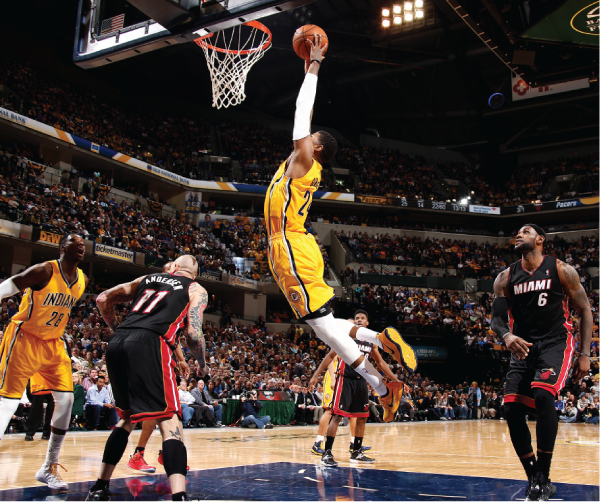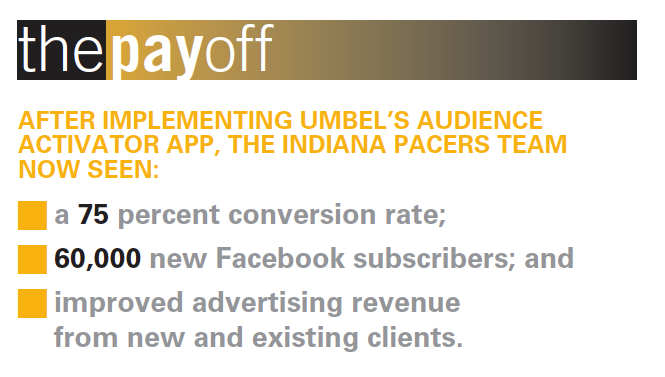Umbel’s Data Unlocking Platform Is a Slam Dunk for the Indiana Pacers
Audience activation app helps the team better segment and target its Facebook followers
Umbel’s Data Unlocking Platform Is a Slam Dunk for the Indiana Pacers
Audience activation app helps the team better segment and target its Facebook followers
Umbel’s Data Unlocking Platform Is a Slam Dunk for the Indiana Pacers
Audience activation app helps the team better segment and target its Facebook followers

Photo Credit: Indiana Pacers
“The audience activator app harnessed key data points...to help the Pacers better target their advertising.”

With more than 2 million followers on Facebook, the Indiana Pacers have no shortage of enthusiastic supporters, but pinpointing the niche groups within such a massive audience and determining how to target individual segments can be a challenge. Promising to deliver data omnipotence, business intelligence solution provider Umbel was “the best company for that job,” Rob Laycock, the team’s vice president of marketing, says.
For the Pacers, getting a deeper understanding of their followers was a crucial step in not only boosting social media engagement, but also activating the fan base and growing ticket sales through targeted advertising. The problem with using third parties or agencies to accomplish these goals, however, is that fan data becomes too fragmented in the process. “They take your audience data without asking and use it to make millions. They’re collecting [it] and you’re not asking for it back. They most likely know much more about your audience than you do,” H.O. Maycotte, CEO of Umbel, says.
Umbel, on the other hand, puts the data collection and segmentation process back into the hands of companies through audience activator apps that marketers can deploy themselves. An audience activator can be a coupon, a contest, an invitation to an event, an opportunity to use free Wi-Fi, a survey, or a ticket giveaway. Regardless of its form, the activator is used as a launching pad for custom responsive apps that collect big audience data in real time. “We use this initial data as a sample set that can help us get a thorough understanding of fan-base nuances, determine what certain subgroups have in common, and start to build a segment profile,” Maycotte explains.
The Pacers’ marketing team chose to use a contest app as their audience activator, and created a Facebook campaign that would invite fans to sign up for a contest to win a VIP package—an exclusive experience that guaranteed prime seating in the arena and other perks. The campaign ran every time the Pacers won a game, and prompted fans to sign up through social log-in, meaning they agreed to share some social media information in exchange for contest entry.
“This was a great way for us to get rich data in a way that was transparent to our fans,” Laycock says. “By gaining access to certain aspects of fans’ social media profiles, the audience activator app harnessed key data points, such as fan ‘likes,’ to help the Pacers better target their advertising,” Maycotte adds. For example, he explains, the tool is able to determine which Indiana Pacers fans are also University of Indiana fans, which creates a unique segment that can be fed to a retargeting tool, such as Facebook Ads. As more activation campaigns are launched and new fans participate, the segmentation gets deeper and data sets become richer.
And Umbel’s Audience Reach Extension tool can take that data segment even further—through a partnership with marketing technology company Acxiom and with the help of its own patent--pending Digital Genome audience analysis technology, Umbel can take an advertising campaign past the scope of Facebook, Twitter, and LinkedIn’s off-the-shelf retargeting capabilities. Much like genetic sequencing, the sequencing of a “digital genome” is an attempt to understand the “bits that make up the whole, with each bit representing one specific data point,” Maycotte explains. “It’s a representation of a person’s digital presence. We’ve got one sequence per person, and roughly 600 million people in the system right now,” he adds.
This approach allows for high-level segmentation, and also leverages machine learning to deliver predictive analytics. “The tool can ultimately predict the kinds of individuals that will buy from a brand even if they haven’t made a prior purchase,” Maycotte explains. This allows companies to identify and target totally new customers. For the Pacers, this meant 60,000 new Facebook followers—that’s three times the capacity of Bankers Life Fieldhouse, the team’s home arena.
Because Umbel’s tool allowed the Pacers to better segment their data and target more specific audience groups, 75 percent of those who visited the Pacers’ sweepstakes page on Facebook converted to email subscribers by completing the content form. “We needed to establish that foundation of data...and reach those fans in relevant ways,” Laycock explains. “From there, we continued to use activator campaigns and change our ad copy based on what we learned about our fans and targeting them more effectively. The results were solid,” he adds, “and we’re looking forward to other integrations, including a campaign through our mobile app.” —Maria Minsker